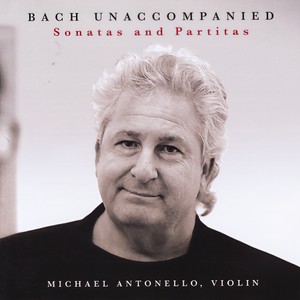
- 歌曲
- 时长
Disc 1
-
作曲家:Johann Sebastian Bach
-
作品集:Sonata No. 1 in G Minor, BWV 1001
-
作品集:Partita No. 1 in B Minor, BWV 1002
-
作品集:Sonata No. 2 in a Minor, BWV 1003
Disc 2
-
作曲家:Johann Sebastian Bach
-
作品集:Partita No. 2 in D Minor, BWV 1004
-
作品集:Sonata No. 3 in C Major, BWV 1005
-
作品集:Partita No. 3 in E Major, BWV 1006
简介
What if modes of artistic expression were arranged not by subject, such as music, drama, literature, painting, etc., but by the onstage lifestyle they imposed on the performer? What if one brought together all the lone performers who had nothing but an empty stage and a spotlight to do their thing? Then, all the following could be grouped under one category: Stand-up comedians, mimes, actors in one-man shows, solo a capella singers, and poets. Pianists would fit, but not piano music, which, as it has developed from Bach to composers such as Rachmaninoff, Scriabin, and Szymanowski, has come to imitate and resemble that of an orchestra, incorporating harmony, color, and melody. Into the hermetic image of such a lone figure onstage belong the solo works of Bach: three suites for violin, three partitas for violin, six suites for cello, and one suite for flute. Although the music contained in these works bears all the hallmarks of Bach’s musical personality, sometimes including polyphony, the striking feature of these works is how alone the music makes the performer appear to the audience. If a Brandenburg concerto is like the field of riches one encounters at a summer arts festival such as Edinburgh’s—where one can get one’s cultural fix, morning, noon, and night, with a dazzling selection of drama, music, dance, literature, film, art, comedy, and more—a Bach instrumental solo is like a deserted Scottish isle, where one stands on the cliffs, blown about by the cold wind, too strong even for seagulls, observing the rocks and foggy surf down below, out of sight of human habitation or human existence or any life other than a few tough tufts of heather clinging to the rocks, utterly alone. Bach’s music in this genre deals almost exclusively with melody; harmony is only implied, never blatant. To achieve such an incredible depth of expression using melody alone makes these works unique in the annals of music. It also makes them dense with musical expression; Johannes Brahms, who made a famous piano transcription of the Chaconne (from Partita No. 2) for left hand alone, wrote to Clara Schumann about the music: On one stave, for a small instrument, the man writes a whole world of the deepest thoughts and most powerful feelings. If I imagined that I could have created, even conceived the piece, I am certain that the excess of excitement and earth-shattering experience would have driven me out of my mind. Many composers of the past took pride in being proficient in writing for every type of instrumental and vocal combination. Yet solo works such as these are absent from the canon of Mozart, Beethoven, Schubert, Brahms, and most other major composers. The Belgian violinist Eugene Ÿsaye (1858-1931), who spent his performing life inspiring violin and piano works or violin concertos from other composers, produced six magnificent sonatas of his own for solo violin (and one for cello), all showing inspiration from Bach. The third begins with the opening to Bach’s E major partita, and it turns into a mad fantasy on it, in fact titled Obsession. Each of his sonatas is dedicated to a different violinist, and fitted to their style of playing. The third sonata, titled Ballade, is perhaps the only piece in the entire literature which, in its ability to project extremes of passion, could be compared to Bach’s Chaconne. The Chaconne and the E major Prelude are frequently performed by themselves, and both have benefited (or suffered) from being transcribed for other instruments. Busoni’s transcription of the Chaconne for piano, is markedly inferior to the original, though Horowitz and others have performed it. On the other hand, Rachmaninoff’s transcription of the E major Prelude is a wonderful piece, beginning in the style of Bach and ending in the style of Rachmaninoff (1873-1943), resulting in a vast and magical two-century metamorphosis, compacted and reduced to the space of a mere five minutes. The Ÿsaye works are the only ones which could be considered to have the depth of feeling and range of emotion of Bach’s works. With the exception of the Prokofiev Sonata, the Paganini Caprices, and possibly Reger’s third cello sonata, no other works in this medium have come remotely close to such lasting popularity. This is a partial list of instrumental solo music for which recordings are available: Heinrich Biber (1644-1704): Passacaglia and Chaconne Telemann (1681-1767): 12 Fantasias for violin Niccolò Paganini (1782-1840): 24 Caprices, considered virtuoso show pieces Max Reger (1873-1916): 3 suites for solo cello; a violin sonata Fritz Kreisler (1875-1962): Recitatif and Scherzo Béla Bartók (1881-1945): solo violin sonata Sergei Prokofiev (1891-1953): solo violin sonata Paul Hindemith (1895-1963) Sonata for violin Henri Vieuxtemps (1820-1881): 6 pieces for violin Ástor Piazolla (1921-1992): 6 etudes for flute or violin Alfred Schnittke (1934-1998): one fugue for violin Bach composed his solo violin works between 1703 and 1720. He worked briefly in Weimar with an older composer, Joahnn Westhoff, who published partitas for solo violin, showing Bach the possibilities for composing in this form. No one knows who, if anyone, performed these works publicly during Bach’s lifetime. Bach himself was more than capable, having received far more training on the violin than on the organ or the harpsichord, even though he eventually became known as a virtuoso on those two keyboard instruments. (Peter Arnstein)







